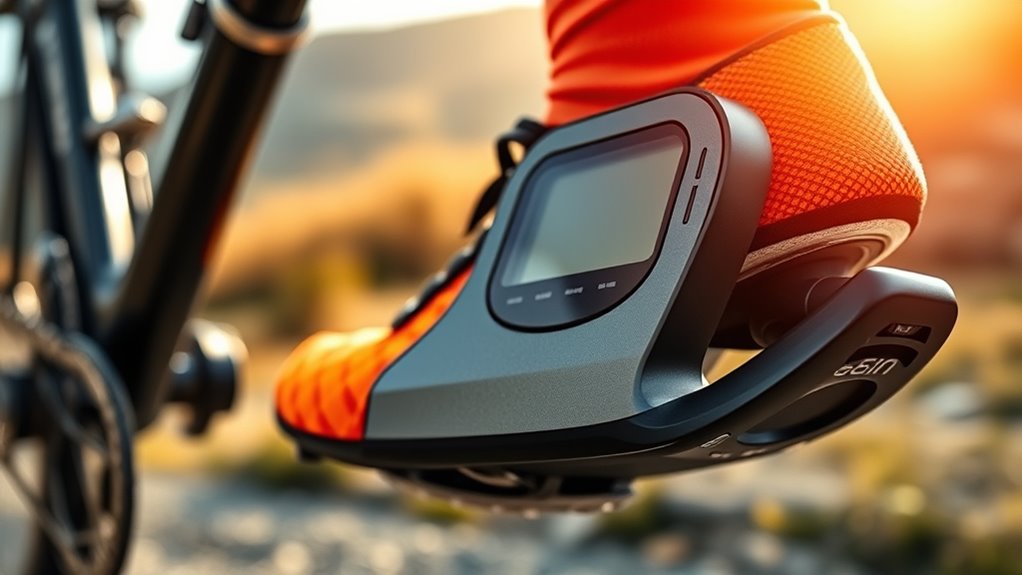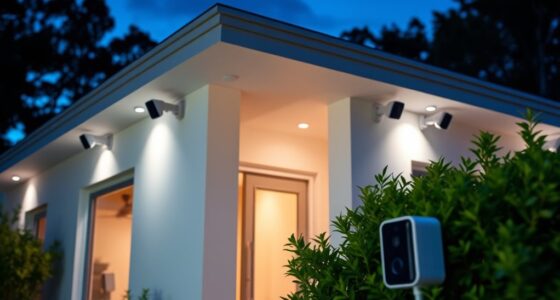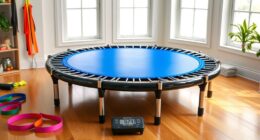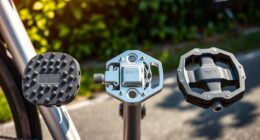If you’re after the best cycling power meters for peak performance, I recommend models like the Favero Assioma PRO MX-2, Garmin Rally RS200, and the Assioma UNO Side Pedal. These offer high accuracy, durable design, and easy transfer between bikes. Many support Bluetooth and ANT+ for seamless connectivity. To get the perfect fit for your riding style and needs, check out the key factors to contemplate—more details await as you explore further.
Key Takeaways
- Pedal-based power meters like Favero Assioma and Garmin Rally offer accurate, reliable data with easy installation and transferability between bikes.
- High battery life (up to 120 hours) and quick charging ensure continuous training without interruptions.
- Compatibility with various bike types and cleat systems (SPD, SPD-SL) makes them versatile for road, MTB, gravel, and triathlon riding.
- Advanced sensors, gyroscope technology, and calibration features provide precise wattage, pedal stroke analysis, and performance tracking.
- Seamless connectivity with Bluetooth and ANT+ enables integration with cycling computers, apps, and training platforms for peak performance analysis.
Favero Assioma Pro MX Power Meter Pedals with Extras
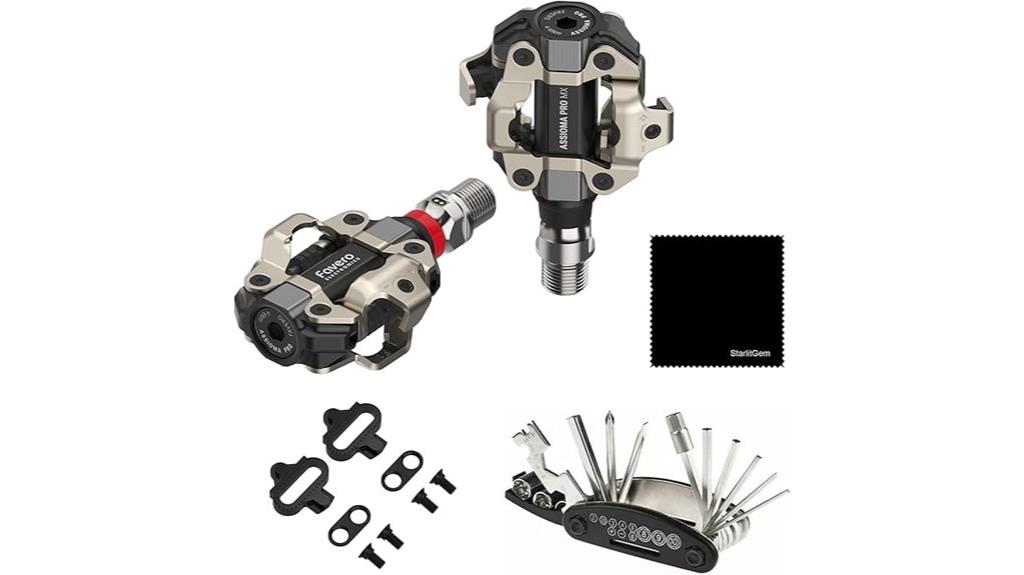
If you’re looking for a reliable, versatile power meter for MTB or gravel riding, the Favero Assioma Pro MX Pedals are an excellent choice. They’re compatible with SPD cleats and connect via Bluetooth and ANT+, making them easy to pair with your bike computer or training apps like Zwift or Strava. Installation is quick, and swapping them between bikes takes minutes—no special tools needed. The set includes extras like cleats, a multi-tool, cleaning cloth, and accessories. Built from durable aluminum, they’re shock-resistant and lightweight. With a rechargeable battery lasting over 60 hours, they deliver precise, real-time power data for both casual and serious cyclists.
Best For: cyclists seeking a durable, accurate, and versatile power meter for MTB and gravel riding that easily integrates with various bike computers and training apps.
Pros:
- Easy to install and swap between bikes without special tools
- Fully SPD compatible with included cleats and accessories
- Long-lasting rechargeable battery with over 60 hours of use
Cons:
- Higher price point compared to entry-level power meters
- Slightly heavier than some compact pedal options due to robust construction
- Requires periodic calibration for optimal accuracy
Favero Assioma Uno Pedal Cycling Power Meter with Cleats & Cleaning Cloth Bundle
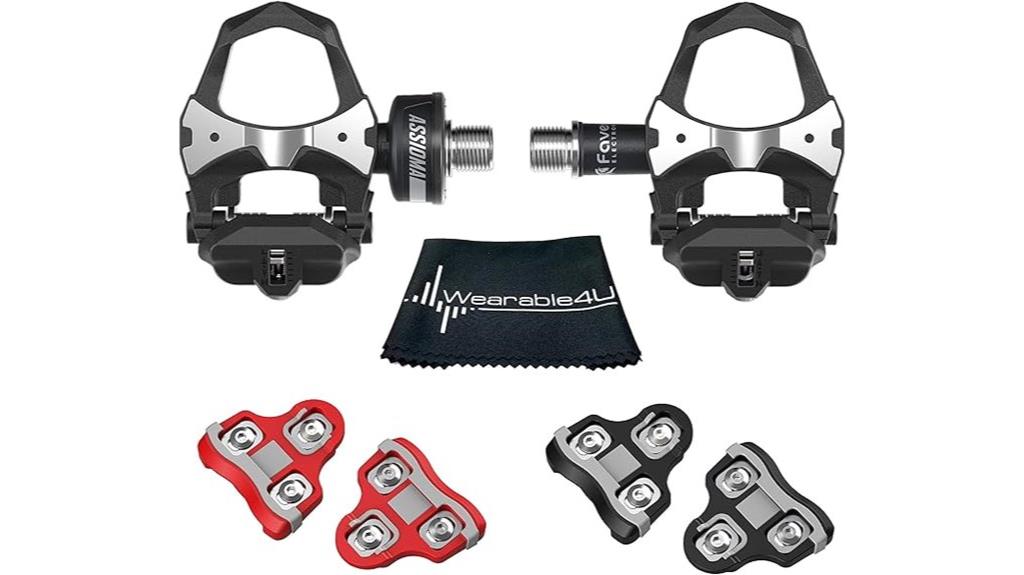
The Favero Assioma Uno Pedal Cycling Power Meter with Cleats & Cleaning Cloth Bundle is an excellent choice for serious cyclists who want accurate, detailed performance data without hassle. These pedals are easy to install and transfer between bikes, making setup seamless. They include sensors in the left pedal for precise power measurement, along with a pair of Favero Red and Black Cleats for customization. The package also features a cleaning cloth for maintenance. With rechargeable batteries lasting up to 50 hours and automatic stand-by mode, these pedals deliver reliable data on power, cadence, and pedal efficiency to help you optimize your ride.
Best For: serious cyclists and training enthusiasts seeking accurate, detailed power data with easy setup and transferability across multiple bikes.
Pros:
- Easy to install and transfer between bikes without special tools
- Provides comprehensive pedaling analytics including left/right balance and torque efficiency
- Long-lasting rechargeable batteries with up to 50 hours of use and automatic stand-by mode
Cons:
- Requires initial setup and calibration for optimal accuracy
- Slightly higher price point compared to basic pedal models
- Battery charging may be inconvenient if not regularly maintained
Assioma UNO Side Pedal Based Power Meter
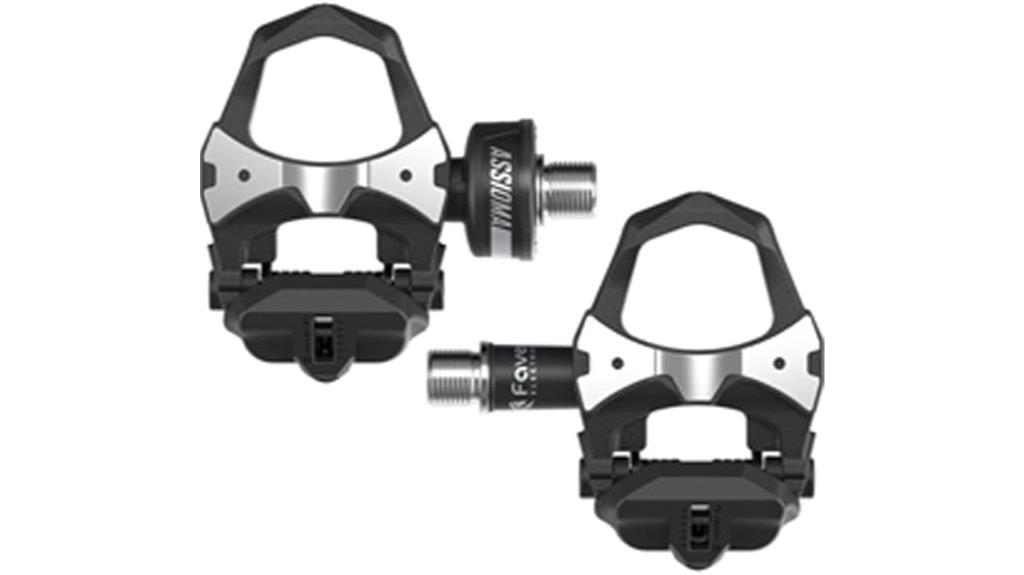
Cycling enthusiasts seeking precise, pedal-based power measurement will appreciate the Assioma UNO Side Pedal Based Power Meter, especially since it offers accurate data from a single pedal. Its easy installation and rechargeable batteries, providing around 50 hours of use per charge, make it practical for daily training. The advanced cycling technology guarantees high certainty in power readings, helping you optimize every pedal stroke. Compatibility with Bluetooth and ANT+ means it seamlessly connects to most bike computers and smartphones, whether Android or iOS. Designed to improve your performance through reliable, detailed data, the Assioma UNO is a smart choice for serious cyclists.
Best For: Serious cycling enthusiasts and athletes seeking precise, pedal-based power measurement to optimize training and improve performance.
Pros:
- Accurate, high-certainty power data from a single pedal side
- Easy to install with rechargeable batteries offering around 50 hours of use
- Compatible with Bluetooth and ANT+ for seamless connection to various devices
Cons:
- May be more expensive compared to basic power meters
- Requires regular charging to maintain battery life
- Limited to cycling applications, not suitable for other sports
Garmin Rally RK200 Dual-Sensing Power Meter Pedals
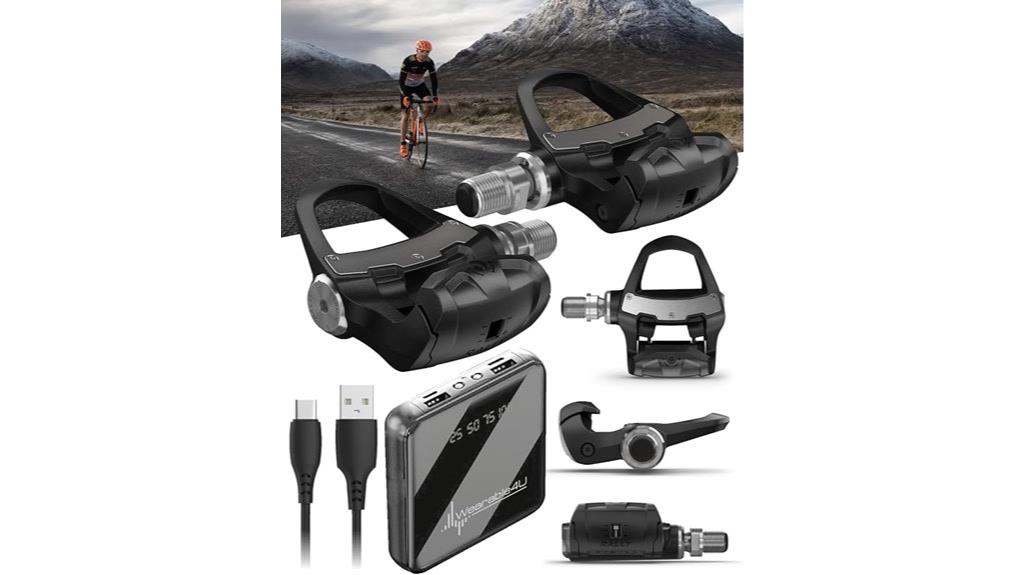
For serious cyclists seeking accurate, all-encompassing performance data, Garmin Rally RK200 Dual-Sensing Power Meter Pedals stand out as an excellent choice. These pedals deliver reliable power measurements and advanced cycling dynamics, even under extreme conditions. Compatible with LOOK KEO cleats, they install like standard pedals and easily transfer between bikes, making them versatile for both road and mountain riding. They track key metrics such as total power, cadence, left/right balance, pedal stroke efficiency, and power phase. With up to 120 hours of runtime, they support long rides and intense training, providing comprehensive data to optimize your performance.
Best For: serious cyclists and training enthusiasts seeking precise power data and advanced cycling dynamics to enhance their performance across various terrains and riding styles.
Pros:
- Accurate and reliable power measurements even under extreme conditions
- Compatible with LOOK KEO cleats and easily transferable between bikes
- Extensive metrics including cadence, left/right balance, pedal stroke efficiency, and power phase
Cons:
- May be more expensive compared to basic pedal models
- Requires compatible Garmin devices or apps for full functionality
- Installation and calibration may require some technical knowledge for optimal setup
Favero Assioma PRO MX-1 Cycling Power Meter with Bluetooth & ANT
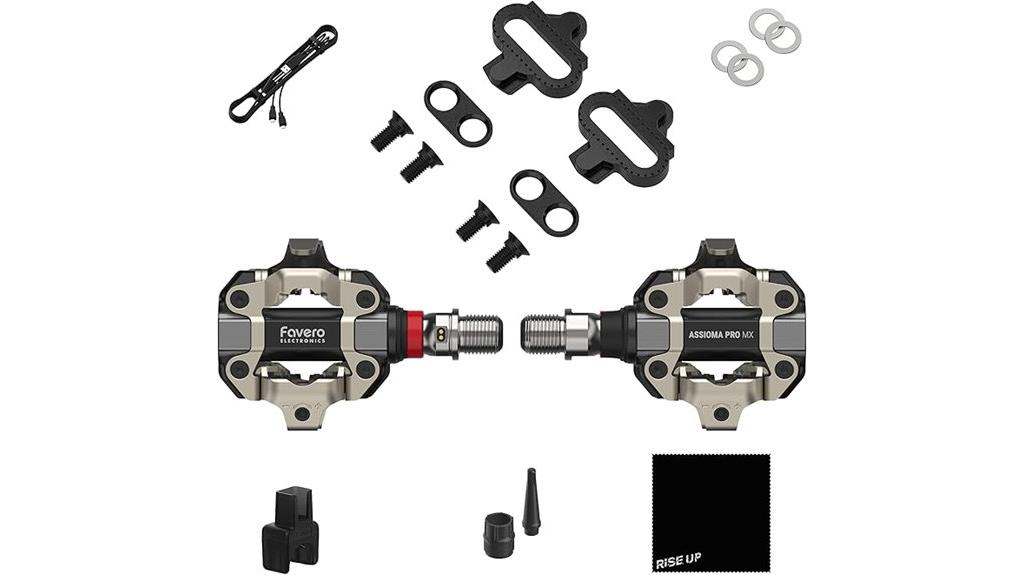
If you’re serious about MTB or gravel riding and want precise power data without fuss, the Favero Assioma PRO MX-1 is an excellent choice. Its pedal-based SPD design offers accurate measurements with ±1% precision, thanks to advanced IAV Power technology and a three-axis gyroscope. The modular design allows quick swaps between MTB and road pedal bodies, and it’s compatible with any crank, oval or round chainrings. Built from durable aluminum, these pedals resist shocks and harsh conditions. With Bluetooth and ANT+ connectivity, over 60 hours of battery life, and all-encompassing metrics like left/right balance and pedal smoothness, they’re a reliable, versatile option for serious riders.
Best For: Serious MTB and gravel riders seeking highly accurate, durable, and versatile power measurement tools to enhance their performance across all terrains.
Pros:
- Highly accurate power data with ±1% precision using advanced IAV Power technology and gyroscope
- Modular design for easy swapping between MTB and road pedal bodies, compatible with various cranksets and chainrings
- Long-lasting rechargeable battery with over 60 hours of use and robust aluminum construction for durability
Cons:
- Installation may require some familiarity with pedal setup, especially for first-time users
- Slightly higher price point compared to basic pedal-based power meters
- Requires compatible Shimano cleats and some adjustment for optimal cleat positioning
Garmin Rally RK200 Dual-Sensing Power Meter Pedals

The Garmin Rally RK200 Dual-Sensing Power Meter Pedals stand out as an excellent choice for serious cyclists who want precise, real-time performance data. These pedals deliver reliable power measurements, advanced cycling dynamics, and compatibility with LOOK KEO cleats. They measure total power, cadence, left/right balance, pedal stroke efficiency, and other key metrics, helping you fine-tune your training. Built for durability, they house sensors in a sleek carbon composite or plastic housing and install like standard pedals, making transfers easy. With up to 120 hours of runtime and seamless connectivity to Garmin devices and apps like Strava, they’re ideal for both road and mountain biking.
Best For: serious cyclists and training enthusiasts seeking precise, real-time power metrics and advanced cycling dynamics for both road and mountain biking.
Pros:
- Accurate dual-sensing power and cadence measurement for comprehensive data
- Seamless compatibility with Garmin devices and popular training apps like Strava and TrainingPeaks
- Durable build with a sleek design, supporting extended rides up to 120 hours
Cons:
- Slightly higher cost compared to basic pedal options
- Requires LOOK KEO cleats, which may necessitate additional purchase or compatibility checks
- Limited availability initially, with first release scheduled for January 2025
Garmin Rally RS100 Power Meter Pedals
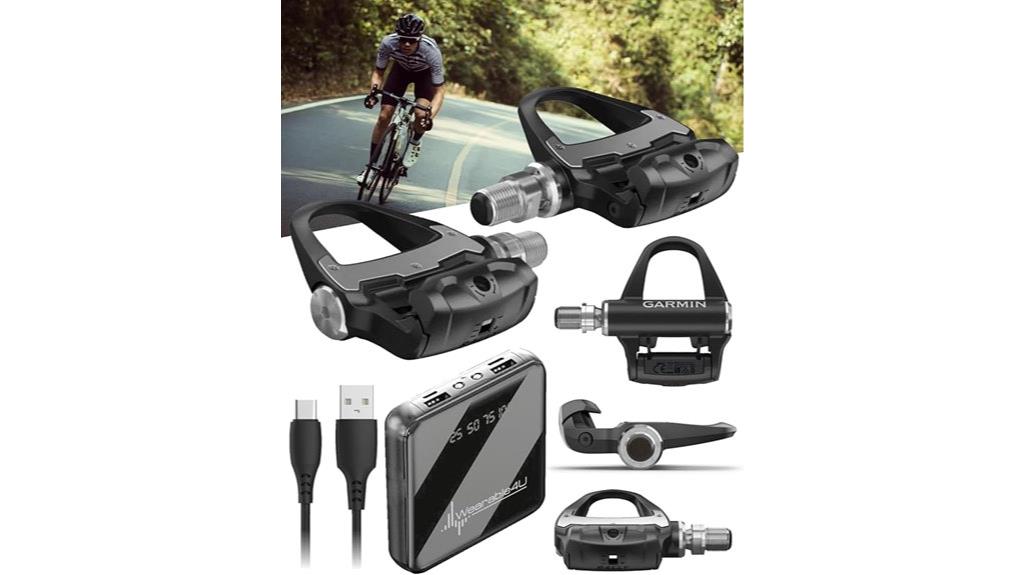
Garmin Rally RS100 Power Meter Pedals stand out as an excellent choice for road cyclists who want reliable, single-sensing power data without the complexity of dual sensors. These pedals measure power from the left leg and double the value for total output, providing accurate, consistent metrics. They’re compatible with SHIMANO SPD-SL cleats, ensuring secure engagement, and are built to withstand extreme conditions across various terrains. Easy to install and transfer between bikes, they also support future upgrades to dual-sensing. Paired with Garmin cycling computers or third-party apps, the RS100 delivers seamless performance tracking, making them a solid option for serious riders.
Best For: road cyclists seeking reliable, single-sensing power data with easy installation and transferability across bikes.
Pros:
- Accurate measurement of left-leg power with doubling for total output
- Compatible with SHIMANO SPD-SL cleats for secure engagement
- Durable construction tested for extreme conditions and versatile terrains
Cons:
- Only provides single-sensing (left leg) data unless upgraded to dual-sensing
- Weighs 330 grams, which may be slightly heavier than some competitors
- Limited to compatibility with Garmin devices and select third-party apps
Favero Assioma Uno Pedal Cycling Power Meter Bundle

Cycling enthusiasts seeking accurate, easy-to-transport power measurement tools will find the Favero Assioma Uno Pedal Cycling Power Meter Bundle an ideal choice. This bundle includes a set of pedals with built-in sensors that measure left-leg power, providing precise data on your pedaling efficiency. It’s simple to install and switch between bikes without special tools, making it perfect for versatile training setups. The pedals feature rechargeable batteries with up to 50 hours of use and quick, magnetic charging. Along with cleats and a cleaning cloth, the Assioma Uno offers detailed insights into torque, balance, and pedal smoothness, helping you optimize your performance effortlessly.
Best For: cyclists seeking an accurate, portable, and easy-to-install power measurement solution for versatile training and performance optimization.
Pros:
- Easy to install and transfer between bikes without special tools
- Provides comprehensive pedaling analytics including left/right balance and torque efficiency
- Rechargeable batteries last up to 50 hours with quick magnetic charging
Cons:
- Requires proper cleat compatibility for optimal performance
- Sensor placement may need careful adjustment for maximum accuracy
- Price point may be higher compared to basic pedal models
Magene P715 Power Meter Pedals for Cycling
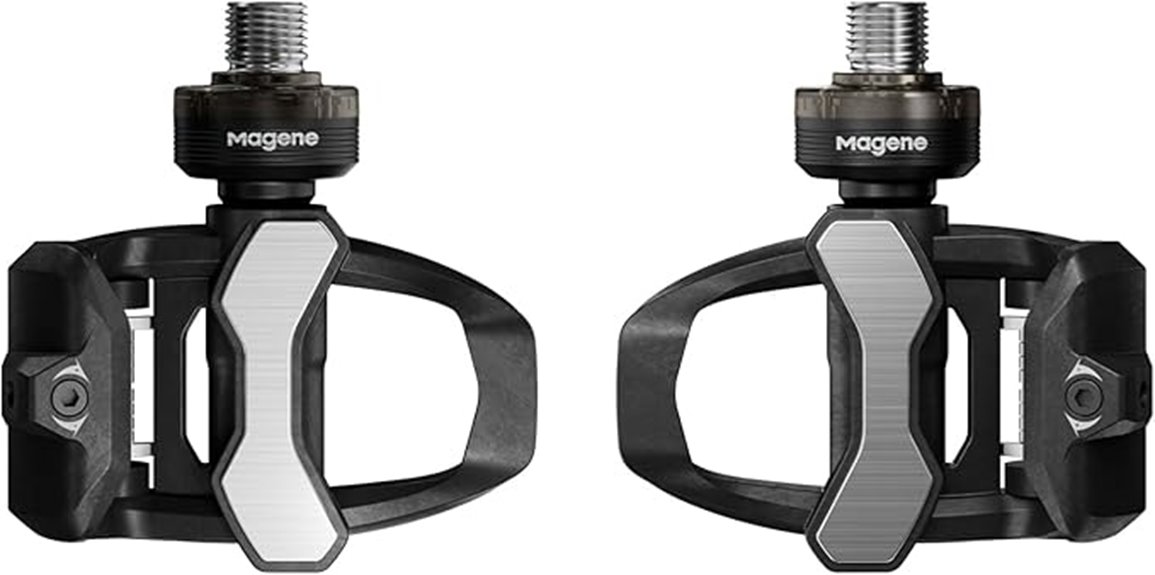
If you’re looking for precise and reliable power measurement in your cycling sessions, Magene P715 Pedals stand out as an excellent choice. They deliver ±1% accuracy and are compatible with KEO and LOOK DUAL cleats, making them versatile for various bike setups. Weighing just 157 grams per pedal, they strike a great balance between lightweight design and durability, thanks to aluminum construction and IPX7 waterproofing. With 7 training functions, long-lasting 120-hour battery life, and easy installation, these pedals support all-encompassing analysis and hassle-free use. They come with a two-year warranty, backed by positive reviews praising their precision and user-friendly features.
Best For: cyclists seeking precise, reliable power measurement with easy installation and versatile compatibility for both indoor and outdoor riding.
Pros:
- ±1% accuracy ensures highly reliable power readings for training and performance analysis
- Lightweight at 157 grams per pedal, combining strength with minimal weight
- Long battery life of 120 hours supports extended training sessions without frequent charging
Cons:
- Only compatible with KEO and LOOK DUAL cleats, limiting pedal compatibility options
- Installation and calibration may require some initial setup familiarity
- Limited review data as the product is relatively new, with only two reviews so far
Garmin Rally XC100 Single-Sensing Power Meter Pedal
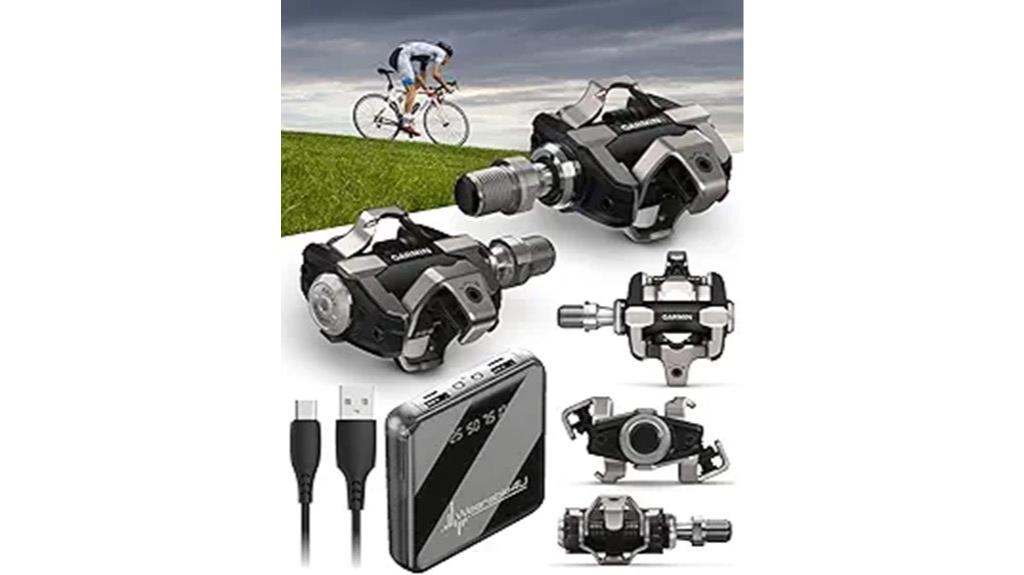
The Garmin Rally XC100 Single-Sensing Power Meter Pedal is an excellent choice for riders seeking a durable and versatile pedal that easily transfers between bikes. It’s compatible with SHIMANO SPD cleats and installs like a standard pedal, making swapping straightforward. The pedal measures power on the left side and doubles the figure for total output, with an upgrade option to dual-sensing for more detailed metrics. Built for rugged conditions, it offers reliable data tracking and seamless integration with Garmin devices and third-party apps like Strava. Its transferable spindle and simple setup make it ideal for multi-discipline riders aiming for consistent performance tracking across different bikes.
Best For: cyclists seeking a durable, versatile, and easily transferable power meter pedal suitable for road, mountain, gravel, and cyclocross riding.
Pros:
- Compatible with SHIMANO SPD cleats and installs like a standard pedal for easy swapping between bikes
- Reliable single-sensing power measurement with the option to upgrade to dual-sensing for more detailed metrics
- Seamlessly integrates with Garmin devices and popular third-party apps like Strava and TrainingPeaks for comprehensive performance analysis
Cons:
- Measures power only on the left side, which may limit insights unless upgraded to dual-sensing system
- Slightly heavier at 330 grams, potentially affecting weight-sensitive riders
- Availability is projected from January 2025, which could delay purchase for immediate needs
Wearable4U Favero Assioma Duo Pedal Cycling Power Meter Bundle
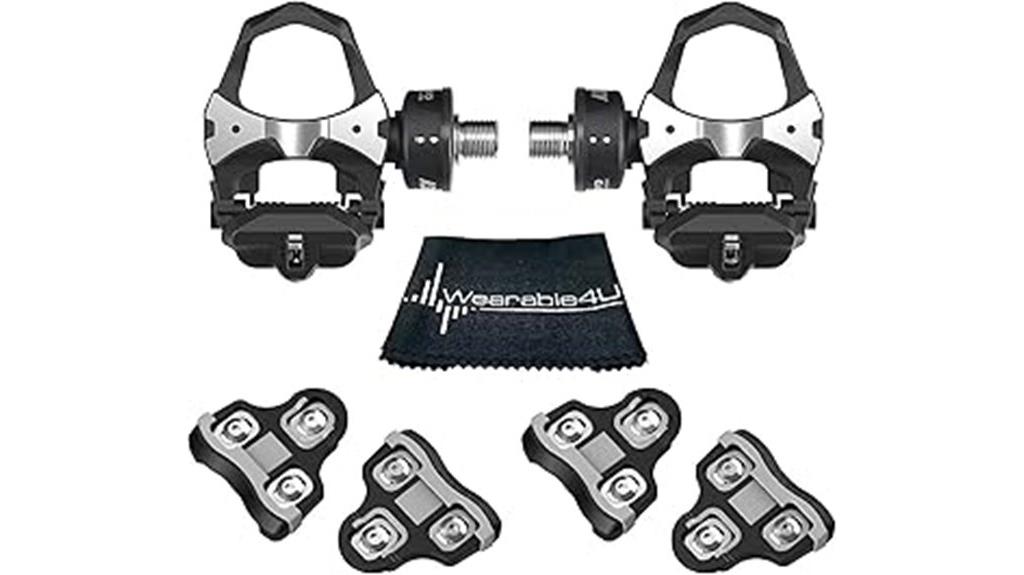
For serious cyclists seeking precise, real-time power data, the Wearable4U Favero Assioma Duo Pedal Cycling Power Meter Bundle stands out as an excellent choice. These pedals feature dual sensors that measure each leg’s power output, providing detailed insights into balance and efficiency. They’re easy to install, transfer between bikes, and don’t require calibration. With an accuracy within 1%, rechargeable batteries lasting up to 50 hours, and compatibility with ANT+ and BLE devices, they suit both training and racing. The sleek aluminum design and modern look add durability and style. Users praise their reliability and data quality, making them a top pedal-based option for performance-focused cyclists.
Best For: serious cyclists and triathletes who demand accurate, real-time power measurement for training and racing optimization.
Pros:
- Provides precise left/right power data with an accuracy within 1% for detailed performance analysis.
- Easy to install, transfer between bikes, and compatible with most ANT+ and BLE cycling devices, including Garmin.
- Rechargeable batteries last up to 50 hours, reducing ongoing costs and hassle of disposable batteries.
Cons:
- Some users report issues with app connectivity and data transmission, affecting user experience.
- Limited customer support options may lead to frustration when troubleshooting problems.
- Slight weight difference compared to traditional pedals may require adjustment for some riders.
Garmin Rally RS200 Dual-sensing Power Meter with Wearable4U Power Bank Bundle
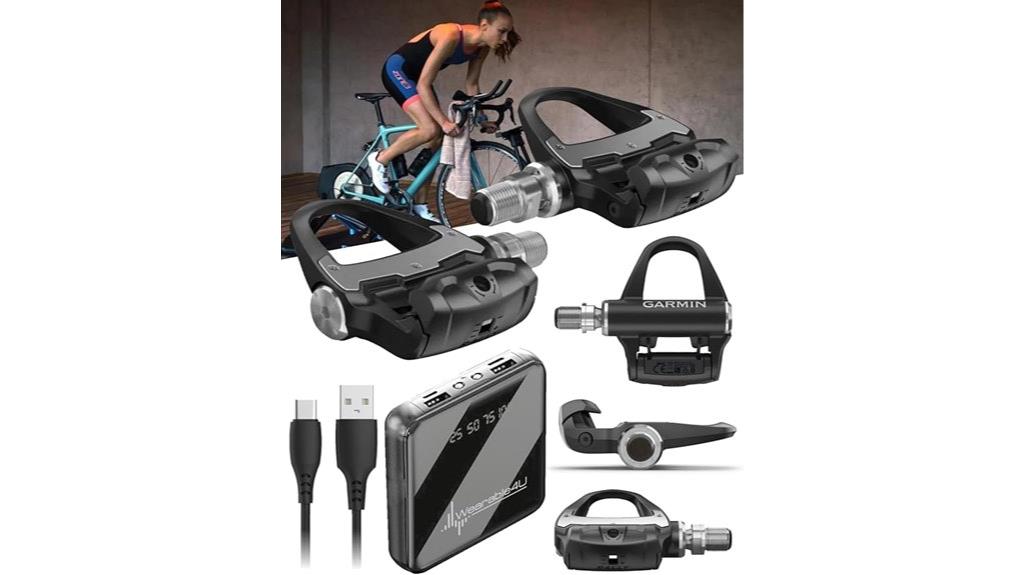
Cycling enthusiasts seeking reliable, advanced power measurement tools will appreciate the Garmin Rally RS200 Dual-sensing Power Meter bundled with the Wearable4U Power Bank. These pedals feature a sleek design with internal sensors, compatible with SHIMANO SPD-SL cleats, and install like standard pedals for quick transfer between bikes. They deliver detailed metrics such as left/right balance, seated versus standing time, and pedal stroke efficiency, helping tailor training. With up to 120 hours of battery life, they’re perfect for long rides. The bundle includes the pedals, cleat hardware, Q-factor washers, and a power bank, ensuring extended use and power management on demanding rides.
Best For: cycling enthusiasts and serious trainers seeking precise power measurement, advanced cycling analytics, and long-lasting battery performance for extended rides.
Pros:
- Provides comprehensive metrics including left/right balance and pedal stroke efficiency
- Compatible with SHIMANO SPD-SL cleats and easy to install like standard pedals
- Up to 120 hours of battery life for extended training and long-distance rides
Cons:
- May require initial calibration and setup for optimal accuracy
- Internal sensors could be susceptible to water or dirt if not properly maintained
- Higher price point compared to basic pedal or power meter options
Favero Assioma PRO RS-1 Cycling Power Meter Pedal
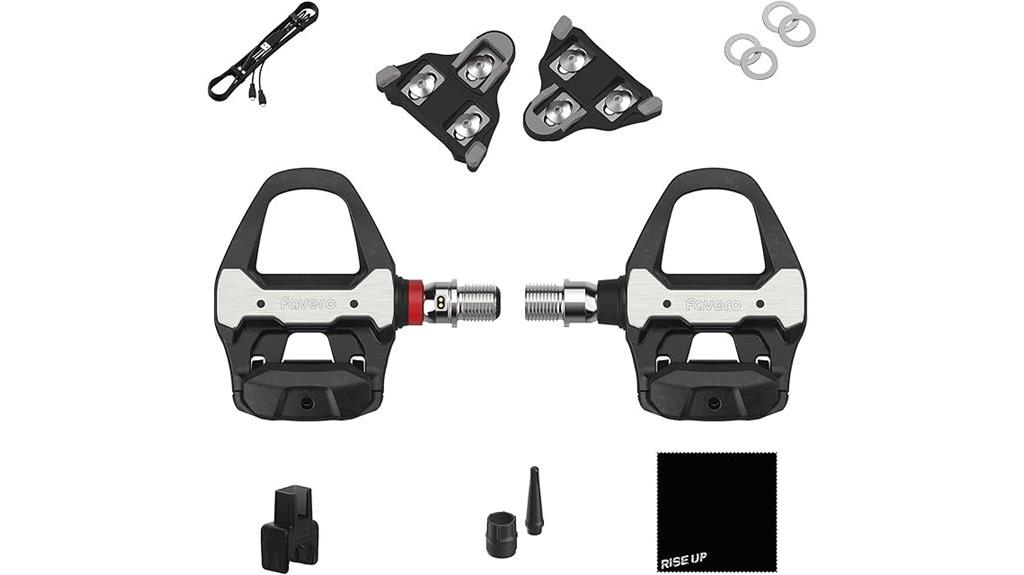
If you want a highly accurate and versatile power meter that easily adapts to both road and mountain biking, the Favero Assioma PRO RS-1 is an excellent choice. Its universal compatibility with SPD-SL systems makes installation straightforward, and you can swap pedal bodies in seconds, switching between bikes without hassle. The modular design houses advanced electronics and a rechargeable battery that delivers over 60 hours of use. With ±1% accuracy, IAV Power, gyroscope technology, and automatic temperature compensation, it provides reliable, consistent data in diverse conditions. The package includes everything needed for easy setup and maintenance, making it ideal for serious cyclists seeking precision and flexibility.
Best For: serious cyclists and triathletes seeking a highly accurate, versatile power meter that easily transitions between road and mountain biking setups.
Pros:
- High precision with ±1% accuracy and gyroscope technology for real-time pedal stroke analysis
- Modular design allows quick swapping of pedal bodies for multi-bike use without additional tools
- Long-lasting rechargeable battery providing over 60 hours of continuous use
Cons:
- Compatibility limited to SPD-SL systems, not compatible with SPD mountain bike cleats
- Slightly higher price point compared to basic pedal-based power meters
- Requires periodic maintenance and cleaning to ensure optimal performance
Favero Assioma PRO MX-2 Cycling Power Meter with Pedals and Cleats

The Favero Assioma PRO MX-2 Cycling Power Meter stands out as an ideal choice for riders seeking versatility and accuracy across different terrains, thanks to its fully SPD-compatible pedal design. Its modular system allows quick swapping between road and MTB setups while keeping the same power sensor, making it incredibly flexible. Installation is straightforward, with no special tools needed, and it connects easily via Bluetooth and ANT+ to your devices. The built-in rechargeable batteries last at least 60 hours, and the durable aluminum body ensures resilience on rough trails. Overall, the MX-2 offers precise measurement, reliable performance, and convenience for versatile cycling adventures.
Best For: cyclists seeking a highly accurate, versatile, and durable power meter compatible with both MTB and gravel bikes, offering seamless swapping between road and MTB setups.
Pros:
- Fully SPD-compatible pedal design with modular system for quick swapping between bike types
- Accurate ±1% measurement with automatic temperature compensation and advanced gyroscope technology
- Long-lasting rechargeable batteries providing at least 60 hours of use per charge
Cons:
- May require initial setup and calibration for optimal performance
- Slightly higher cost compared to basic pedal-based power meters
- The modular design, while flexible, may need careful handling during swapping to avoid damage
Assioma PRO MX-1 Single Sided Power Meter Pedals
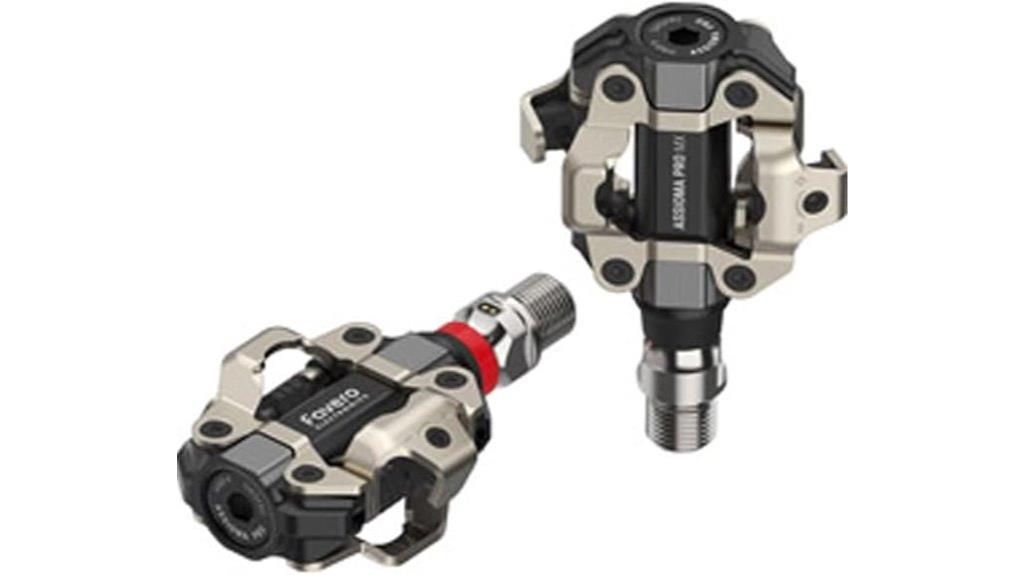
Looking for precise power measurement with minimal setup? The Assioma PRO MX-1 Single Sided Power Meter Pedals deliver just that. They feature advanced sensor tech that provides accurate wattage data from your left pedal, helping you track and improve performance. Made from durable alloy steel and aluminum, they’re lightweight yet built to last across gravel, cyclocross, and mountain biking. Compatibility is a breeze—they connect via Bluetooth and ANT+, syncing effortlessly with your cycling computer or training apps. Easy to install and reliable in all conditions, these pedals are perfect for riders who want dependable, real-time power data without fuss.
Best For: cyclists who seek accurate, reliable power measurement with easy setup and seamless integration across various riding conditions.
Pros:
- Provides precise wattage data from the left pedal with advanced sensor technology
- Compatible via Bluetooth and ANT+ with cycling computers and training apps for real-time monitoring
- Durable construction using alloy steel and aluminum, suitable for gravel, cyclocross, and mountain biking
Cons:
- Single-sided measurement may require additional pedals for full power data
- First available date (March 9, 2025) suggests limited current market availability
- Price and availability are subject to change, potentially affecting purchase options
Factors to Consider When Choosing Cycling Power Meters (And Pedal-Specific)
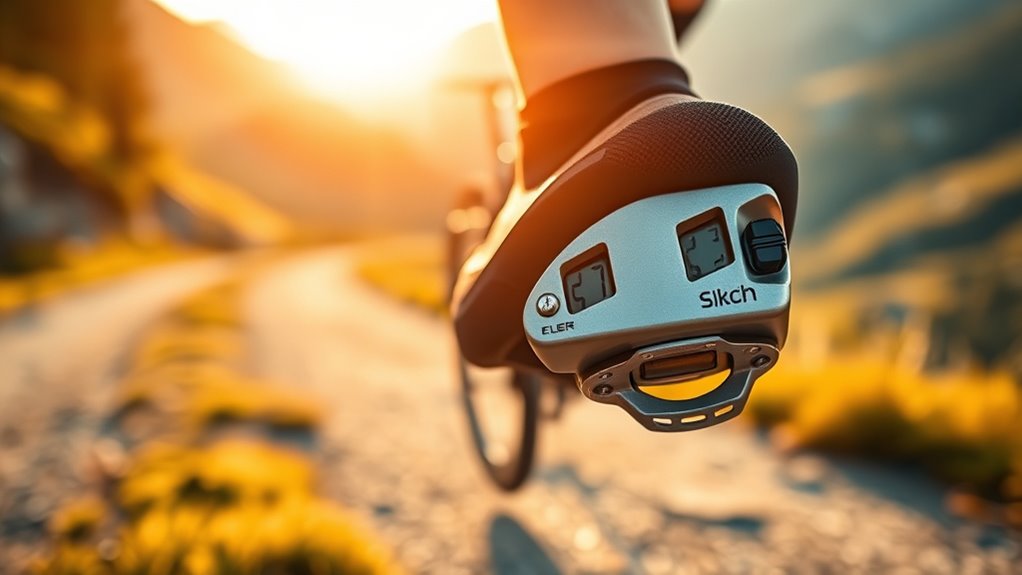
When selecting a cycling power meter, I consider factors like compatibility with my bike type and how accurate the measurements are. I also look at connectivity options, battery life, and how easy it is to install. These points guarantee I choose a device that fits my riding style and maintenance preferences.
Compatibility With Bike Type
Choosing a cycling power meter that matches your bike type is crucial for accurate data and dependable performance. First, verify the pedals are compatible with your bike’s cleat system, such as SPD, LOOK KEO, or Shimano SPD-SL, for proper engagement. Next, confirm that the pedal design suits your bike—whether it’s a road, mountain, gravel, or cyclocross bike—to handle terrain conditions and durability needs. Additionally, check if the power meter supports your crank arm and bottom bracket configuration, especially for non-standard or integrated setups. Consider whether the pedals are designed for your riding discipline; MTB and gravel bikes often require different shock resistance and cleat compatibility. Finally, ensure that the sensor placement and electronic housing fit your frame design, guaranteeing peak performance and longevity.
Power Measurement Accuracy
Ever wondered how accurately your power meter measures your efforts? Power measurement accuracy is usually expressed as a percentage of total wattage error, with top-tier pedals hitting ±1% or better. Dual-sided meters offer a more precise picture by comparing data from both pedals, helping you understand your left/right balance and overall output. Calibration plays a big role; models with automatic or minimal calibration tend to stay reliable over time. Advanced sensor technologies, like IAV Power and gyroscopes, improve accuracy by tracking pedal stroke dynamics and adjusting for temperature changes. Keep in mind, external factors like temperature fluctuations, terrain, and installation torque can influence readings. Choosing a pedal with proven accuracy and easy calibration ensures your data stays consistent, helping you train smarter.
Connectivity Options & Compatibility
Understanding how your power meter connects to your devices is key to getting reliable data during rides. Most power meters support Bluetooth, ANT+,, or both, which affects compatibility with cycling computers and smartphones. If you use multiple devices, choosing a model with dual connectivity can simplify setup. Pedal-based power meters must match your bike’s crankset, pedal threading, and cleat system—whether SPD, LOOK KEO, or Shimano SPD-SL—to ensure proper fit and accurate readings. Some models require specific apps or ecosystems for setup and calibration, impacting usability. Additionally, compatibility with third-party platforms like Strava, TrainingPeaks, or Zwift allows seamless data transfer and better training analysis. Ensuring compatibility with your gear and preferred apps is essential for a smooth, effective training experience.
Battery Life & Charging
How long your cycling power meter’s battery lasts can make a big difference in your training routine. Some models offer up to 120 hours of use per charge, while others provide around 50 hours, so it’s essential to choose one that fits your riding schedule. Rechargeable batteries are common in pedal-based power meters, allowing quick recharging through magnetic connectors or USB-C cables—no need for disposable batteries. Most units charge within a few hours, enabling fast turnaround between rides. Many power meters also include automatic stand-by or sleep modes to conserve battery life when not in use, extending overall usage time. Additionally, durability and resistance to extreme temperatures guarantee consistent performance, especially if you train in harsh conditions.
Ease of Installation
Choosing a cycling power meter that’s easy to install can save you time and frustration, especially if you frequently switch between bikes. Pedal-based power meters are designed with simplicity in mind, matching standard pedal sizes and threading, so swapping them out requires no special tools. Many models have magnetic or plug-and-play charging connectors, making maintenance straightforward. Some pedals even feature modular designs, allowing quick removal and transfer between bikes, which is perfect for multi-bike setups. Compatibility with common cleat systems like SPD or Look KEO ensures secure attachment and easy detachment during installation. Clear instructions or included multi-tools help you calibrate and set up your power meter efficiently, minimizing the learning curve and getting you on the road faster.
Durability & Weather Resistance
When selecting a cycling power meter, durability and weather resistance are essential to guarantee reliable performance in all riding conditions. I look for models with high surface hardness ratings, such as up to 800 HV, to withstand impacts and rough terrain. Weather resistance is equally critical; an IPX7 or higher waterproof rating ensures protection against rain, mud, and splashes. Components housed in sealed enclosures made from durable materials like aluminum or composites prevent damage from dust and dirt. Long-lasting rechargeable batteries with magnetic chargers are also a plus, especially for extended rides. I prefer units tested under extreme conditions, including temperature swings and moisture exposure, to ensure they can handle diverse outdoor environments without fail. Durability and weatherproofing are key for consistent, dependable data.
Price & Value
Price and value are crucial factors when selecting a cycling power meter, especially since the right investment can profoundly enhance your training without breaking the bank. Higher-priced pedal-based models often provide greater accuracy, longer battery life, and advanced features, offering better overall worth for serious cyclists. Budget-friendly options might sacrifice some precision or durability but still deliver reliable data for casual riding and training. Evaluating the cost per hour of use—considering battery life and lifespan—helps reveal the true worth of a model. Additional features like multi-device compatibility, easy transfer between bikes, and extensive analytics can make pricier options more appealing. Ultimately, choosing a pedal-specific power meter that balances price, performance, and durability ensures long-term satisfaction and cost-effectiveness.
Frequently Asked Questions
How Do Pedal-Based Power Meters Compare to Hub or Crank-Based Models?
You’re wondering how pedal-based power meters compare to hub or crank-based models. I find pedal-based meters offer great flexibility—they’re easy to transfer between bikes and measure individual leg power accurately. Hub and crank-based models tend to be more stable and might be more durable for rough conditions. Overall, I think pedal meters are ideal for versatility, while hub or crank options suit riders seeking long-term reliability.
Are Power Meters Compatible With All Cycling Bike Types?
You’re wondering if power meters work with all bike types. I’ve found that most modern power meters are quite versatile and compatible with a wide range of bikes, including road, mountain, and hybrid models. However, it’s crucial to verify specific compatibility details like crank type, bottom bracket standards, or pedal compatibility. I always recommend double-checking with the manufacturer to ensure seamless integration with your bike.
What Is the Typical Battery Life for Pedal-Specific Power Meters?
Imagine your pedal-powered engine, humming smoothly. That’s how I see pedal-specific power meters—reliable, like a trusted companion. Typically, they last about 50 to 100 hours on a single charge, depending on usage and model. I always recommend carrying a spare or charging regularly, so your ride stays uninterrupted. Think of it as fueling your engine—necessary for peak performance and seamless riding.
Can I Transfer Power Meter Data Seamlessly Between Devices?
You’re wondering if you can transfer power meter data seamlessly between devices. I’ve found that most modern power meters use ANT+ or Bluetooth, making data transfer pretty straightforward. I just pair my device once, and then I can sync data with my bike computer, smartphone, or training platform effortlessly. Some brands even offer dedicated apps for quick data sharing, so you don’t have to worry about manual uploads or complicated setups.
How Accurate Are Dual-Sensing Versus Single-Sensing Pedal Power Meters?
Thinking about accuracy, dual-sensing pedal power meters are like a two-sided mirror, offering a more complete picture of your power output. They tend to be slightly more precise than single-sensing models because they measure both pedals independently, catching any discrepancies. While single-sensing meters are reliable, dual-sensing options provide an extra layer of accuracy, making them ideal for serious cyclists aiming for peak performance.
Conclusion
If you’re serious about smashing your cycling goals, investing in one of these top power meters is like giving your ride a secret weapon. They’re precision tools that can elevate your performance to legendary status—faster, stronger, and more efficient than you ever thought possible. Don’t settle for average; gear up with the best, and watch your cycling game reach heights that seem almost impossible. Your future record-breaking self will thank you!
